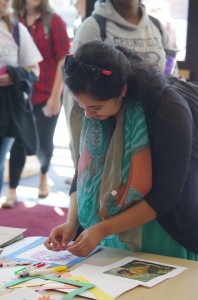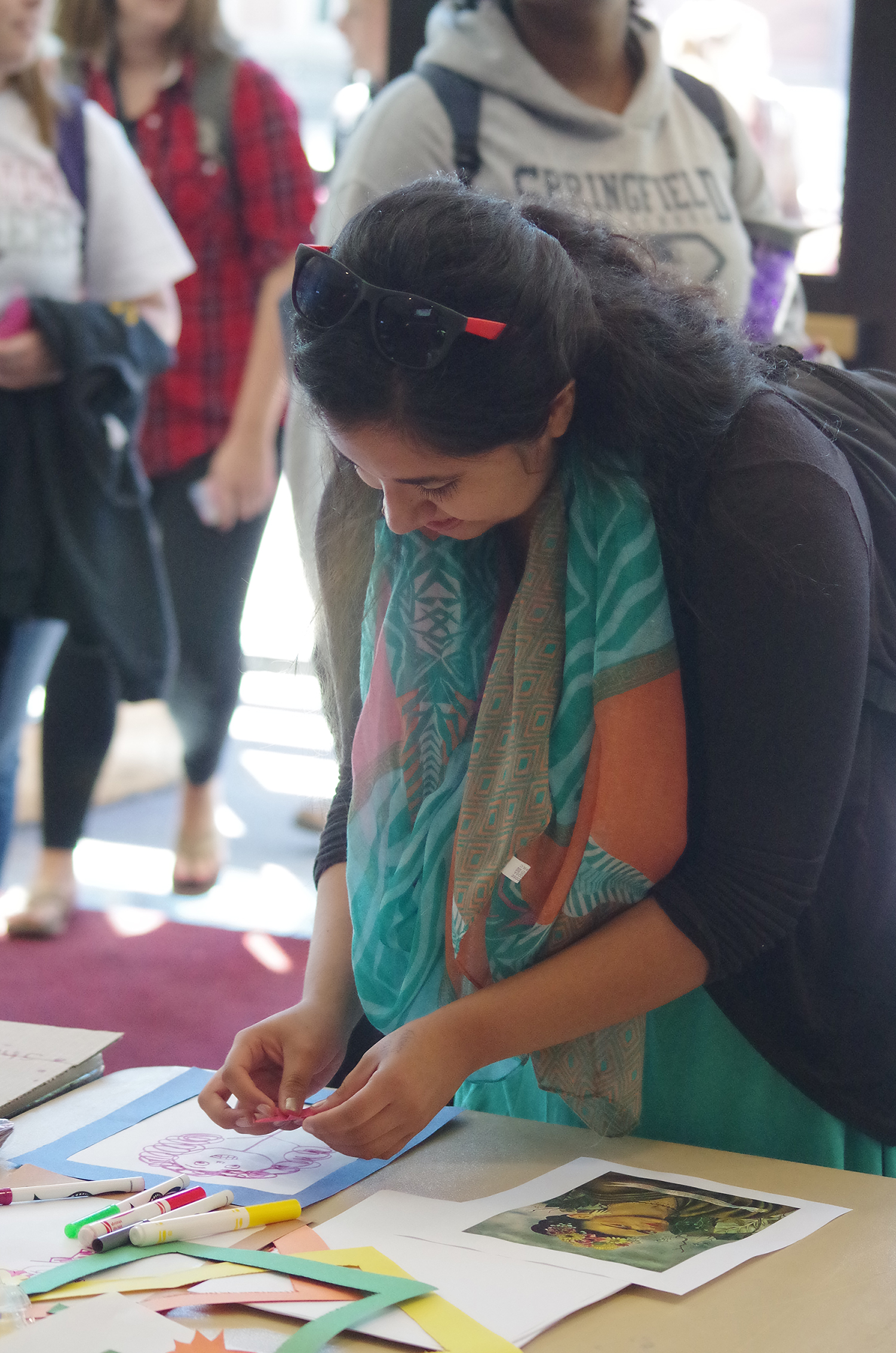
Club often works with Spectrum Resource Center
By Spenser Hickey and Jamell Brown-Smith
Managing Editor and Transcript Reporter
With more than thirty consistent members at each meeting, PRIDE has become one of the largest non-Greek organizations on campus this year.
Coming together each Thursday night, the group provides a safe space for members of marginalized sexual orientations and gender identities, as well as their supporters.
“We try to discuss as many different identities as possible, in order to bring awareness to those identities, and in order to create a safe space for people with identities that might be less understood,” said sophomore Natalie French, president, in an email.
As an example, French listed asexuality as a sexual orientation and nonbinary – not male or female – as a gender identity.
As a safe space, the discussions at each meeting are very private; officers caution all members not to discuss anything mentioned there outside the meeting unless explicit permission is given.
At the start, members regularly introduce themselves with their name, class year, preferred gender pronouns and answer to a question of the week, such as favorite ice cream flavor.
“We also discuss current events and popular media,” French said. “This past meeting, we heard Kyle Simon speak about the scientific logistics behind ‘gaydar,’ and the role of genetics in sexuality and gender identity.”
Simon, a senior who’s co-teaching a course on the biological foundations of sexuality this semester, described how research shows humans can unconsciously distinguish whether someone is heterosexual or non-heterosexual – though this includes a wide range of identities – even if they’ve only seen a cutout of their face or just their eyes.
In general, women are better at this than men, Simon said. Due to issues in finding a large enough sample, participants who identify as nonbinary were not included.
French, who joined PRIDE last year and is also a resident of the Women’s House (WoHo), got involved after her experiences as a member of the queer community at a high school she considers conservative.
When referring to either orientation or identity, members use the term “queer” as a reclaimed slur that has been redefined as a more inclusive term.
Fellow WoHo resident Claudia Bauman, a junior, joined PRIDE this year and compared the experience to her membership in Sisters United (SU), a club that focus on issues affecting women of color.
“(SU) is a lot of reading articles and talking about them,” Bauman said. “I really enjoyed that, I learned a lot about certain authors and journalists and ideas, but PRIDE is more about talking to people about their personal stories. It’s a different way to learn the issues, more personal.”
Partnering with Spectrum Resource Center
In addition to regular meetings, PRIDE also works closely with the Spectrum Resource Center, an office in Hamilton-Williams Campus Center that provides information and programming to the OWU community.
“While I cannot speak for the entire resource center, as an intern I can say that I personally am excited about the growing number of visible queer students on Ohio Wesleyan’s campus, particularly the number of first year students who identify on the queer spectrum,” said senior Spectrum intern Liz Dickson.
“It is also encouraging to see such enthusiastic attendance from first year students as a senior because it means that there will be a significant number of queer student leaders on this campus after I graduate,” Dickson said.
Dickson is also a resident of the Women’s House, and they noted several ways Spectrum and PRIDE will be working together.
“Annual collaborations include our National Coming Out Day event, which provides a safe space for students to share their identities with peers, faculty and administration,” they said.
“We also jointly fund a group of students to go to MBLGTACC (the Midwestern Bisexual Lesbian Gay Transgender Ally College Conference) every year in February. This semester, the Spectrum Resource Center and PRIDE are teaming up to bring a disabled transgender Filipino martial artist to campus to do a poetry performance and self defense workshop for the queer community.”
Junior Zoe Morris, a WoHo resident as well, is another Spectrum intern and leads the Queer Artist of the Month events. For September, she selected Frida Kahlo, a famous Mexican painter who was bisexual and open about her relationships both with women and her husband Diego Rivera.
Kahlo, who lived from 1907 to 1954, was also a strong Mexican nationalist who resisted traditional European styles despite criticism from artistic elites.
“(Kahlo) said that she would be better off essentially selling tortillas in a market than in this culture,” Morris said. “She is most famous for her self-portraits.”
During the event, students were invited to create their own self-portraits, often featuring flowers in Kahlo’s style – and many did.
PRIDE Week
So far, PRIDE hasn’t made their presence felt on the campus-wide stage, but that will change next week with PRIDE week, which takes place from Monday Oct. 6 to Friday Oct. 10; National Coming Out Day is Oct. 11.
“During PRIDE Week, we organize ways to bring awareness and recognition to the community,” French said.
They will be tabling throughout the week; events include a performance by spoken word artist J Mase III, a queer trans person of color on Oct. 7. This event was organized by PRIDE Treasurer Alicia Brown, a senior and WoHo resident.
The week closes with PRIDE Prom on Friday, October 10. Other events for PRIDE members specifically will be held during the week.
Beyond PRIDE Week, the club is also focused on increasing membership and discussion of issues in the short term, and an eventual goal of achieving all-gender housing.
“All-gender housing would provide a safe space for trans and non-binary students,” French said.
“As of right now, incoming trans students are placed in medical singles, as the school does not allow them to room with others who share their gender identity.”
“…As members of PRIDE Exec, we have noticed and heard PRIDE members who have a huge need for gender-inclusive housing on campus.”
Past events aimed at raising awareness of the need for gender inclusivity in campus housing have included a presentation on all-gender housing by Rebecca Mosely, then-Assistant Director of Residential Education at Oberlin College, which has all-gender housing options. Her presentation and a following discussion were held at last year’s PRIDE week.
The “Trans-ition Your Outlook” workshops held toward the end of last semester also promoted gender inclusivity, though in more general terms.
